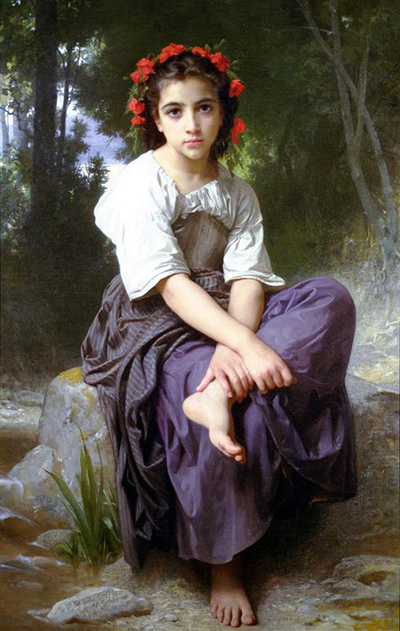William Bouguereau adored peasants and had a soft spot for them.
Indeed, a good number of his globally celebrated masterpieces successfully exalted the peasant life. Ironically, he hailed from a time and place where peasants were subjected to subjugation and even their most endearing traits used to be despised for being of peasant possession.
Nevertheless, his work managed to pacify the dense condescending attitude the society had of peasants as well as their indifference and disregard for the peasants’ plights. In his endeavour to sensitise the world to peasants’ value and valour, he conjured his most sensitive painting yet to be matched from 1875 to present day.
The single figure that William Bouguereau was responsible for painting puts conflicting thoughts and feelings to any viewer’s mind and jolts their creativity to balance contrasting ideas menacingly. The imagery employed is one of constant contrast, an epitome of Bougueau’s mastery of mood and characterisation through avid accentuations of subtle nuances in both.
The painting centres on a young feminine peasant who is neither a girl nor a woman but a complex blend of juvenile youth and adulthood. The feminine young woman is neither kind nor means in her permissiveness for viewers to understand her. She is haughtily beautiful and intricately elusive from comprehension, and her enigma transcends to the confusion the innocence in her facial appearance.
The enigma is evoked not by the presence of that innocence in her visage but by the demeanour of her eyes. Her eyes have the command of a fully mature woman, and her seamless stare at viewers brings them all to a brief stare down, viewers’ eyes chained to hers. In her stare resides serenity embedded in grace and faithfulness.
The stare seemingly demands of those watching to pledge a quiet and secret vow not to betray her trust or confidence. The girl in the painting At the Edge of the Brook ultimately achieves what not even Bougueau himself could have as a person: evoke feelings of honesty and loyalty in nobles towards peasants.
Such feelings are then enforced by the halo of red flowers she adorns her head with to allude to her spirituality in human form.
The masterpiece persists on with its symbolism away from the peasant lady herself. She sits on the edge of a river to symbolise a crossroads that has been lingering in her borderline features between innocent childhood and overbearing adulthood, immaculate beauty and demeaning peasantry. Her hands and legs being crossed further the contrasting theme of conflict.




